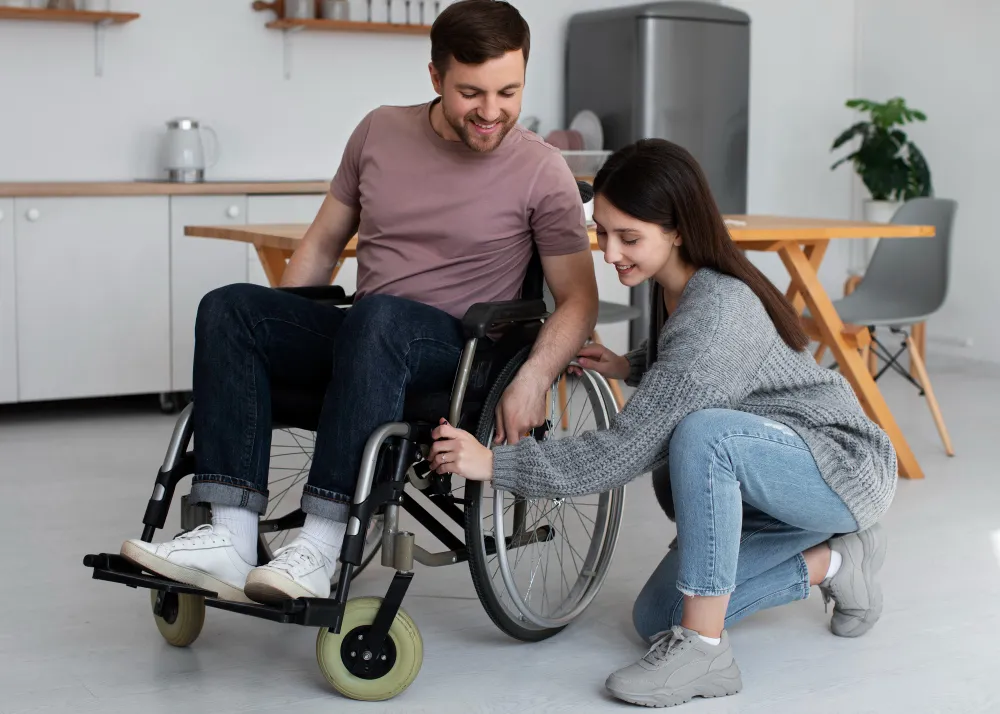Accessing assistive technology through the NDIS usually begins with an assessment. Whether it’s a mobility aid, communication device, or custom seating system, most items require a formal report from a qualified therapist—often an occupational therapist. The report must show why the equipment is essential, how it supports daily activities, and how it links to funded goals in the participant’s NDIS plan.
The NDIS doesn’t fund equipment based on a simple request. It needs clear, functional evidence that the item is reasonable, necessary, and suitable for the person’s disability needs. Without a proper assessment, even basic items can be delayed or declined.
Who needs an assistive technology assessment?

An NDIS assistive technology assessment is essential for participants who require equipment or devices to support independence, safety, or access to everyday life. Whether it’s mobility aids, communication tools, or home modifications, the assessment ensures the right support is chosen and justified for NDIS funding.
You may need an assistive technology (AT) assessment if you:
- Have difficulty with mobility or personal care: If you find it hard to move safely around your home, get in and out of bed, use the bathroom, or carry out tasks like dressing or cooking, an OT can assess what equipment may help—such as transfer aids, shower chairs, or kitchen tools.
- Need support with communication: For those with limited verbal communication, a speech pathologist may assess your needs and recommend communication aids like voice output devices, symbol boards, or tablet-based apps that improve how you interact with others.
- Use equipment that’s outdated, unsafe, or no longer suitable: If your current device isn’t working as it should or doesn’t meet your needs anymore, an assessment can help determine whether a new item—or an upgrade—is required, including proper measurements and trial recommendations.
- Are entering a new stage of life or goal setting: Starting school, transitioning to supported employment, or planning to live independently might mean new equipment is needed. An assessment ensures your AT matches your daily environment and future plans.
- Need complex or customised assistive technology: Any request for Level 2 AT—such as powered wheelchairs, complex postural supports, or custom bathroom solutions—must be backed by a detailed therapist assessment and report for NDIA approval.
- Struggle to use current AT effectively: Even with the right equipment, using it confidently and safely can take time. An assessment often includes personalised training, trial planning, and recommendations for adjustments or accessories.
What happens during the assessment?
An assistive technology assessment is more than a checklist. It’s a practical, hands-on process where a qualified therapist works directly with the participant to understand their needs, trial suitable equipment, and recommend the most appropriate solution. The aim is to make sure the right item is chosen—and that it will genuinely support the participant’s independence and daily life.
Here’s what typically happens during the process:
- Initial discussion and information gathering: The therapist starts by speaking with the participant (and their support person, if needed) to understand what daily tasks are difficult, what the participant would like to do more independently, and what’s currently in place. They might review reports from other professionals or past therapy sessions.
- Environment review: The assessment often happens in the participant’s home or another familiar setting. The therapist will look at layout, access points, and daily routines—like how the participant moves from bed to bathroom, or how meals are prepared and eaten. This helps identify where equipment can make a meaningful difference.
- Functional testing and equipment trials: If suitable, the therapist will organise equipment trials with local suppliers. This might involve trying a wheelchair, testing cutlery grips, or using a communication device to see what works best. The therapist watches closely, checking for comfort, safety, and usability.
- Measuring and documentation: If a custom or fitted item is being recommended, the therapist will take precise measurements. This ensures the item matches the participant’s body and environment. They’ll also take photos if needed (with consent) to support the request.
- Report and recommendations: After the visit, the therapist prepares a written report for the NDIS. It explains what equipment is recommended, why it’s needed, how it supports the participant’s goals, and whether any training or support is required for safe use.
Related: Home Modifications Assessments: What You Need to Know
What does the report include?
The assistive technology assessment report is a key document used to support funding through the NDIS. It’s written by the assessing therapist—usually an occupational therapist, speech pathologist, or physiotherapist—and provides clear, detailed evidence about the participant’s needs and the equipment being recommended.
The report typically includes:
- Participant background and current challenges: This section outlines the participant’s disability, daily routines, and any limitations they experience that affect their ability to take part in everyday life. It also summarises current equipment, if any, and explains why change or support is needed.
- Assessment findings: Based on observation, discussion, and trials, the therapist documents how the participant interacts with different equipment and what worked or didn’t. This part of the report is practical and shows real-life use—for example, how the participant managed to self-transfer using a trial hoist.
- Justification for the recommended item: The report clearly explains why the recommended device is the best option. It includes comparisons to other available products and outlines how the recommended item is the most suitable, safe, and cost-effective choice for the participant’s situation.
- Training, support, or installation requirements: Some AT items require ongoing support to use them safely and effectively. The report will note if the participant needs training (e.g. learning to use a speech device), support from carers (e.g. operating a hoist), or installation work (e.g. grab rails or ramps).
- Quotes and supplier information: To submit to the NDIS, the therapist includes one or more quotes from registered or verified suppliers. These quotes match the equipment described in the report and ensure the cost is transparent and reasonable.
Once complete, the report is submitted alongside quotes for NDIA approval. It plays a major role in whether the assistive technology gets funded.
Related: Disability Bathroom Renovations: Why You Should Involve an Occupational Therapist
What types of assistive technology can be funded?

The NDIS can fund a wide range of assistive technology (AT), from low-cost daily living aids to complex custom-built equipment. What gets funded depends on the participant’s needs, how the item supports their independence, and whether it meets the NDIS criteria of being reasonable and necessary.
Some examples of assistive technology that may be funded after an assessment include:
- Mobility aids: Items like manual or powered wheelchairs, walking frames, crutches, and mobility scooters. Assessments ensure the equipment is suitable for the participant’s body, home layout, and transport needs.
- Communication devices: For participants with limited or no verbal communication, the NDIS may fund speech-generating devices, symbol boards, or iPads with communication apps. A speech pathologist usually conducts this type of assessment.
- Daily living aids: This includes adaptive cutlery, dressing tools, non-slip mats, shower stools, long-handled sponges, or anything that makes self-care tasks easier and safer.
- Transfer and positioning equipment: Hoists, slide sheets, bed rails, pressure cushions, and specialised chairs may be funded for participants who need physical support with moving, positioning, or comfort.
- Home-related modifications: While actual building modifications fall under a different category, assistive technology can include portable ramps, grab rails, and height-adjustable benches or equipment that can be used without permanent installation.
- Technology for learning and access: Tablets, adapted keyboards, screen readers, and sensory input devices may be recommended for participants who benefit from structured learning tools or assistive software.
Each item must be supported by a professional assessment that links the AT to the participant’s daily challenges and long-term goals.
Do low-cost items need an assessment?
Not all assistive technology items require a formal assessment. Under the NDIS, low-cost and low-risk items—usually under $1,500—can often be purchased directly using Core funding, especially if the participant is self-managed or plan-managed. These items are generally considered safe, easy to use, and widely available.
Examples of low-cost assistive technology include:
- Shower chairs or non-slip bath mats
- Long-handled sponges or dressing aids
- Adaptive cutlery or food preparation tools
- Basic sensory items like weighted cushions or fidget tools
- Portable ramps or reachers
While these items don’t always require a written assessment or report, it’s still a good idea to speak with a therapist before buying. A brief consultation helps ensure the item actually suits the participant’s needs, fits the space, and won’t go unused.
In some cases, the NDIS may ask for supporting evidence—even for lower-cost items—especially if the purchase seems unusual or if multiple similar items have already been claimed.
For anything above $1,500 or classified as complex or custom-built, a full assessment and written recommendation from a qualified allied health professional is required.
Final thoughts
An NDIS assistive technology assessment is a key step in getting the right equipment to support independence, comfort, and everyday living. Whether it’s a simple daily aid or a complex custom solution, the process works best when guided by an experienced therapist who understands how to match the right device with real-life needs.
Good assessments lead to better outcomes—safer homes, more control over daily tasks, and improved quality of life. The strongest results come from clear goals, hands-on trials, and honest conversations about what will actually help.
If you’re thinking about assistive technology for yourself or someone you support, contact our team today!

